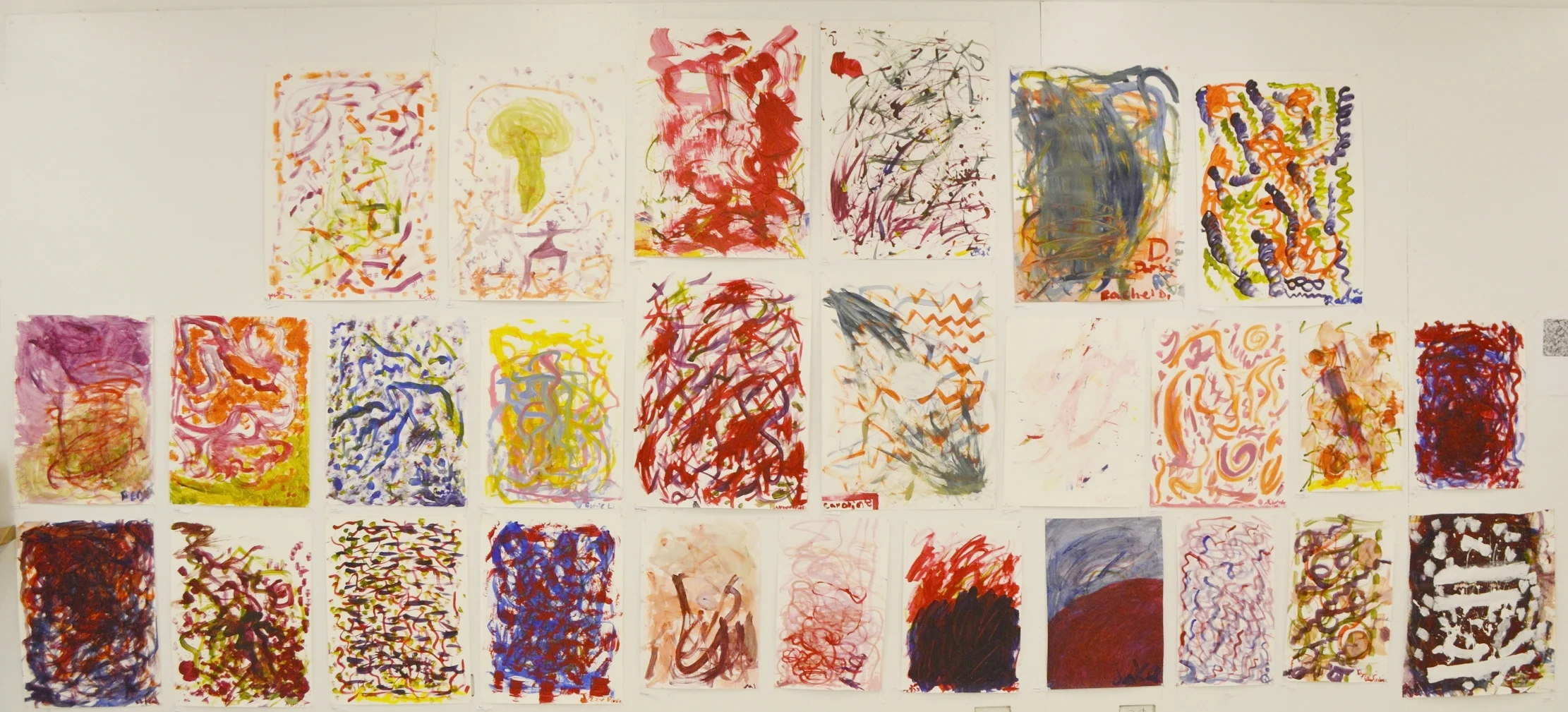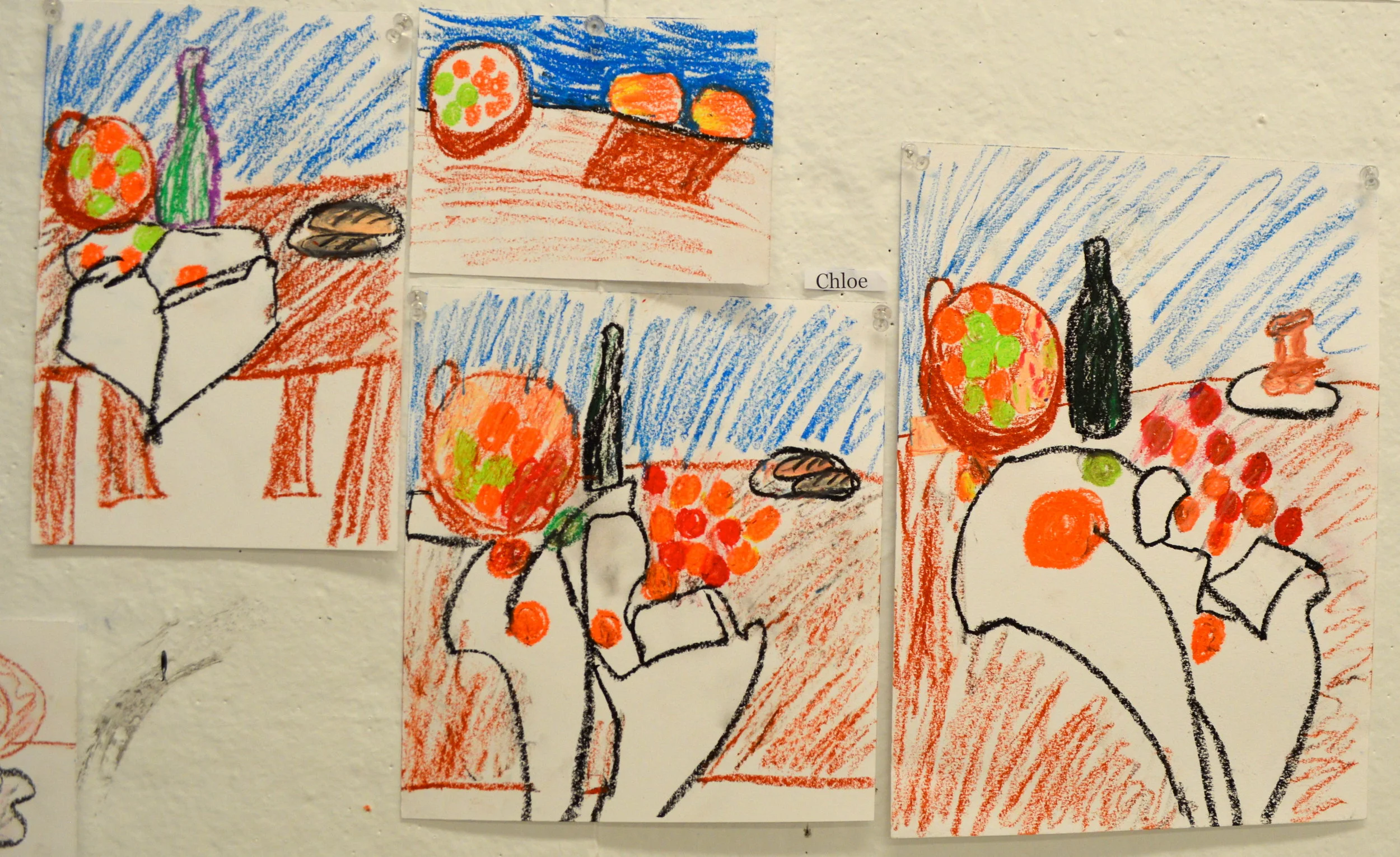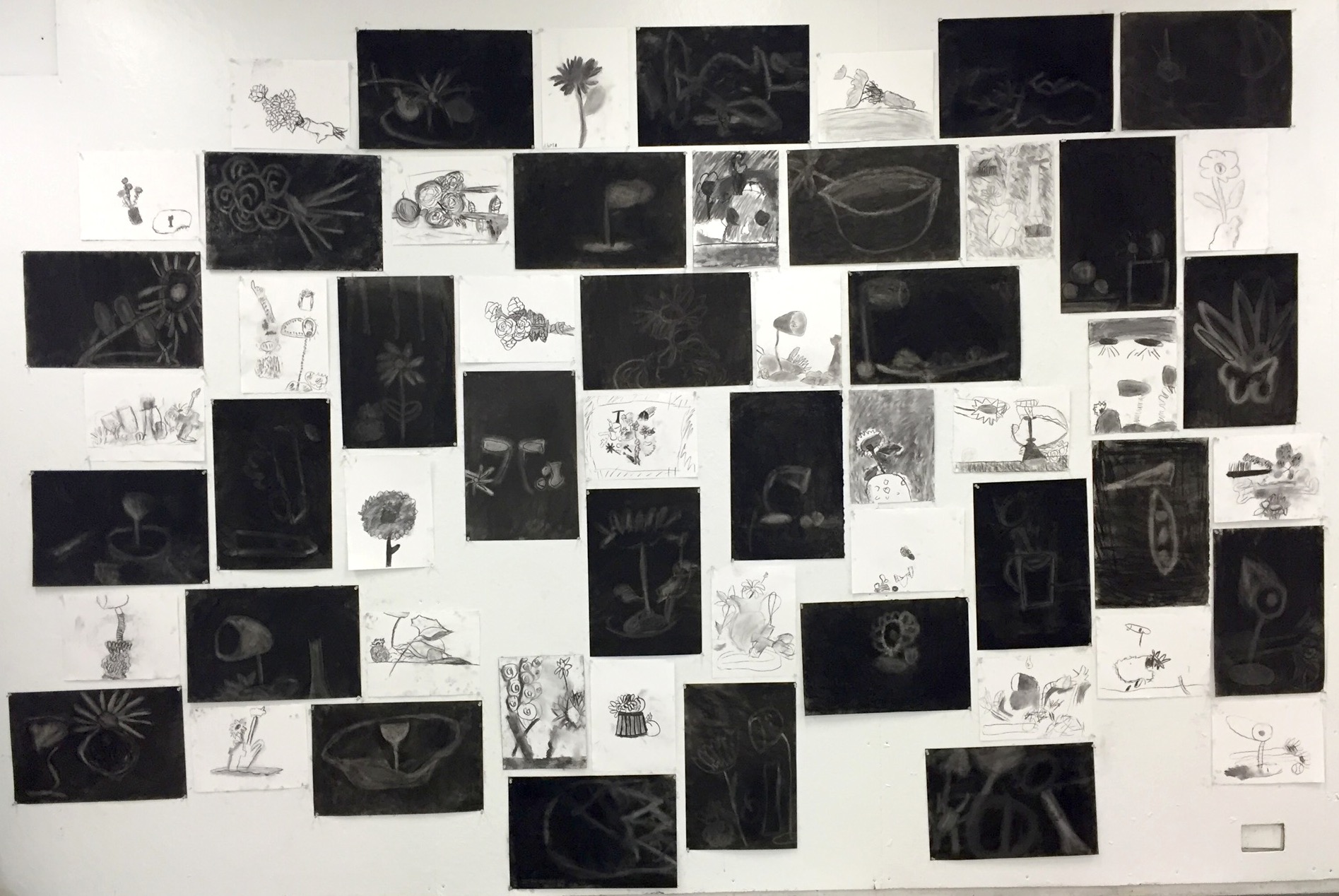
Art Camp 2016 (SAIC)
I, along with a co-teacher, instructed multi-arts camp for 8 and 9 year old students. These camps centered around themes that included abstraction, structures and systems, and process based art. Each one week and two week camp culminated in an exhibition of student work, highlighting lessons learned in techniques, art movements, and artists featured both within the Art Institute and in the broader contemporary art community.

Abstract Expressionism
Students were introduced to the art of Jackson Pollock and the style of abstract expressionism in creating art. We listened to music to inspire various brush strokes, having students mix secondary colors from the primary colors.
Acrylic paint

Detail from Abstract Expressionism Project
Even with a limited palette and the same materials, students' work varied dramatically.

Detail from Abstract Expressionism Project
Even with a limited palette and the same materials, students' work varied dramatically.

Learning Earthworks
We brought the students outside to explore found objects and creating works of art with natural materials. Working in pairs, students were challenged to create as many variances with the materials they picked up along the way.

Detail from Learning Earthworks

Picasso Portraits
Students were introduced to abstracting portraiture by looking at the work of Pablo Picasso. They drew various abstracted facial features with oil pastel, glued each onto a shape of a face, then added pattern with oil pastel and watercolor.

Detail from Picasso Portraits
Each student's work was unique, silly, bright and fun!

Detail from Picasso Portraits
Each student's work was unique, silly, bright and fun!

Detail from Picasso Portraits
Each student's work was unique, silly, bright and fun!

Abstracting Shape
Students listened to a range of music to inspire lines and shapes, adding watercolor to learn blending, and collaging cellophane for transparency.

Exquisite Beasts
Students worked together to create their own mis-mashed creatures in the style of Surrealist artists. They began with the classic game, Exquisite Corpse, taking turns drawing one part of a 3 creature piece.

Exquisite Beasts
Students worked together to create their own mis-mashed creatures in the style of Surrealist artists. They began with the classic game, Exquisite Corpse, taking turns drawing one part of a 3 creature piece. They then worked individually to sculpt from the two dimensional to the three dimensional, adding color and mixed media to their sculptures.

Abstract Mobiles
Looking at the work of Alexander Calder, students created kinetic sculptures using cellophane, cardboard and wire, experimenting with balance and shape.

Foley Folly
Art is more than visual. Here students learned all about the work of foley artists in the making of movies. We crafted our own rain sticks to imitate the sound of an approaching storm.

Foley Folly
Art is more than visual. Here students learned all about the work of foley artists in the making of movies. We crafted our own rain sticks to imitate the sound of an approaching storm.

Abstracting Landscape
The city of Chicago provides a beautiful urban landscape for which to draw inspiration from, however can be challenging to copy. We introduced students to a new perspective on landscape art by looking at the work of Julie Mehretu and abstracting what we see.

What a Chair!
Students learned about systems and structures in the design process of creating and building a chair. We started with initial sketches based on imagined and observed chairs from the museum. Then students worked to create a schematic collage of how they imagined their chairs might look from the front and side before moving on to a scale model out of cardboard. The end result was a working prototype which was then advertised and acted out in a short commercial to sell their products.

Detail from What a Chair!
Pictured is the student's schematic collage showcasing the chosen design elements, as well as their written advertisement to sell the final product.

Detail from What a Chair!

Detail from What a Chair!
A student's prototype for their chair design.

Detail from What a Chair!
Several students' prototypes constructed using chip board, fabric, and found materials.

Paper Mosaics
Looking at the ancient mosaic floor tiles of Pompeii, we constructed our own modern day farmer's market mosaics out of paper. Just as the Pompeians advertised their merchandise in their Macellum, we are advertising various goods that can be found for purchase at a market today.

Student example of Paper Mosaics
Looking at the ancient mosaic floor tiles of Pompeii, we constructed our own modern day farmer's market mosaics out of paper. Just as the Pompeians advertised their merchandise in their Macellum, we are advertising various goods that can be found for purchase at a market today.

Mosaic Tiles
Mosaics are made up of a system of multiple small pieces that when placed together in a pattern construct a whole image. We worked from our paper mosaics to construct patterns with glass tiles. We looked at textiles within the museum's collection as inspiration, mirroring the repetition of line, color and shape in our own work.

Mosaic Tiles
Mosaics are made up of a system of multiple small pieces that when placed together in a pattern construct a whole image. We worked from our paper mosaics to construct patterns with glass tiles. We looked at textiles within the museum's collection as inspiration, mirroring the repetition of line, color and shape in our own work.

Crafty Collections
Collections are a system of organizing similar objects into categories. We considered how the museum functions as a collection, and students created collections of their own using model magic. Looking at ways the museum labels collections of small objects, students emulated this by creating labels of their own illustrating what they have on display.
Example of student work.

Crafty Collections
Collections are a system of organizing similar objects into categories. We considered how the museum functions as a collection, and students created collections of their own using model magic. Looking at ways the museum labels collections of small objects, students emulated this by creating labels of their own illustrating what they have on display.
Example of student's work.

Crafty Collections
Collections are a system of organizing similar objects into categories. We considered how the museum functions as a collection, and students created collections of their own using model magic. Looking at ways the museum labels collections of small objects, students emulated this by creating labels of their own illustrating what they have on display.
Example of student's work.

Crafty Collections
Collections are a system of organizing similar objects into categories. We considered how the museum functions as a collection, and students created collections of their own using model magic. Looking at ways the museum labels collections of small objects, students emulated this by creating labels of their own illustrating what they have on display.
Example of student's work.

Playful Playgrounds
Play isn't often regarded as a system, but the structures built in order to promote play are systematic in their design. Inspired by our desire to play, we designed and created our own playgrounds with abstract and fantastical themes, which we then animated using stop animation and model magic characters. We looked at abstract sculpture such as work done by Alexander Calder as inspiration.
Example of student work.

Playful Playgrounds
Play isn't often regarded as a system, but the structures built in order to promote play are systematic in their design. Inspired by our desire to play, we designed and created our own playgrounds with abstract and fantastical themes, which we then animated using stop animation and model magic characters. We looked at abstract sculpture such as work done by Alexander Calder as inspiration.
Example of student work.

Playful Playgrounds
Play isn't often regarded as a system, but the structures built in order to promote play are systematic in their design. Inspired by our desire to play, we designed and created our own playgrounds with abstract and fantastical themes, which we then animated using stop animation and model magic characters. We looked at abstract sculpture such as work done by Alexander Calder as inspiration.
Example of student work.

Value Study in Mondrian
The work of Piet Mondrian is very systematic in design, articulated with precise decision of colors and line. We emulated this by experimenting with acrylic paints and creating values within a hue. Second works then expanded to include two or more colors expressing this range in hues.

Detail of student work Value Study in Mondrian
The work of Piet Mondrian is very systematic in design, articulated with precise decision of colors and line. We emulated this by experimenting with acrylic paints and creating values within a hue. Second works then expanded to include two or more colors expressing this range in hues.

Faux Frieze and Wacky Weavings

Wacky Weavings
Textiles display a system of steps, from laying the warp, to weaving the weft. We looked at the contemporary work of James Bassler as inspiration for our own spin on traditional design. We started with a standard weaving pattern, intertwining various materials, then overlayed and interjected wires and tissues, elaborating beyond a standard textile.
Example of student work.

Wacky Weavings
Textiles display a system of steps, from laying the warp, to weaving the weft. We looked at the contemporary work of James Bassler as inspiration for our own spin on traditional design. We started with a standard weaving pattern, intertwining various materials, then overlayed and interjected wires and tissues, elaborating beyond a standard textile.
Example of student work.

Wacky Weaving
Textiles display a system of steps, from laying the warp, to weaving the weft. We looked at the contemporary work of James Bassler as inspiration for our own spin on traditional design. We started with a standard weaving pattern, intertwining various materials, then overlayed and interjected wires and tissues, elaborating beyond a standard textile.
Example of student work.

Human Spirograph
With large sheets of paper mounted on the wall and on the floor, students worked to mirror each hand, and sometimes feet, to create images using their body's motions.
Example of student work.

Human Spirographs
With large sheets of paper mounted on the wall and on the floor, students worked to mirror each hand, and sometimes feet, to create images using their body's motions.
Example of student work.





































































































































